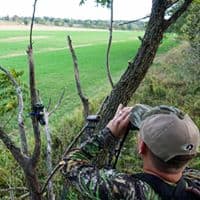Throughout many states, bow season opens during the month of September. This can offer incredible hunting opportunities for whitetails. Trail cameras often reveal bachelor groups on daily routines during this time. These routine movements can be captured during both mornings and evenings. If this is the case, the next question becomes, what time do you hunt this pattern if both times offer daylight opportunities?
When opening day rolls around it is tough to stay out of the treestand as the sunrises. When we consider factors like humidity, wind, foliage, and thermals an answer quickly arises. With a little research and knowledge of the typical weather conditions, evenings far outweigh morning hunts.
A quick look into average humidity levels during September shows humidity levels in the high 80’s most mornings. In comparison, the afternoon’s average is in the low 50’s. The more moisture in the air the easier scent molecules are detected. This is why dogs lick their noses when they are hot on a trail. A thirty percent difference in average the humidity levels from morning to evenings is significant.
Phrases like “still of the morning” aren’t just simple-minded phrases, this is a real thing! When scientists compare wind speeds with temperature, they find that the warmest times of the day coincide with the highest wind speeds. As a hunter, we know the coolest times of the day occurs at daybreak. This is when the sun’s rays have yet to reach the surface of the earth surface. So far, the morning hunts aren’t looking so good for early season hunting.
Another factor that is known to make a large influence on wind especially in areas with terrain differences are thermals. During the mornings as temperatures rise, thermals will follow. This lifts any scent molecules up into the canopy of the trees. Without adequate wind speeds, the scent molecules are susceptible to simply floating around aimlessly. This can spell disaster for hunters attempting to remain undetected.
The last factor that plays a large influence into the poor hunting conditions during the morning is full foliage. The addition of a dense full canopy of trees makes it very difficult for a hunter’s scent to vacate the immediate area without a stiff wind. These conditions would be similar to hunting in an enclosed greenhouse that has a broken fan, not ideal!
As hunters, we have to ask the question, why hunt during those conditions. Waiting till the afternoon for improved conditions may turn the tables just enough to seal the deal. Often times afternoon hunts produce conditions with decreased humidity levels and an increase in winds speeds. Before jumping the gun as the season opens, consider the conditions your area typically produces. Make great decisions when you choose to hunt, keep your woodsmanship skills sharp!
For Love of the Land,
Matt

